Implementing management techniques that enhance deer habitat or improve deer population demographics can be very rewarding. However, the time frame for achieving results often varies, depending on the expectations of the landowner or wildlife management cooperative. When identifying wildlife management goals, be sure they are on-target and cost-effective and that they can be accomplished within a reasonable time.
Time frame for accomplishing goals
Manipulating population demographics
Missouri no longer has breeding populations of major predators of adult white-tailed deer. Therefore, deer populations are now primarily managed through hunting in rural, and in some cases urban, areas of the state. Hunters make a management decision each time they choose whether to harvest a deer. As quality deer management (QDM) philosophies are adopted by landowners or wildlife management cooperatives, each hunter will become more aware of how individual harvest decisions can influence the deer herd’s overall health and population demographics.
Influencing population demographics such as adult sex ratio, fawn recruitment and buck age structure requires an understanding of population dynamics. Each of these population parameters can be influenced by a specific set of management practices, but these practices take time to implement and to show results. Refer to MU Extension publication G9488, Estimating Deer Populations on Your Property: Population Dynamics, for more information.
Before identifying deer population goals, collect baseline demographic information to understand the current state of the herd. This information can be obtained from camera survey, observational and harvest data (Figure 1). For guidance on using these techniques to collect demographic data, refer to the following MU Extension publications on estimating deer populations on your property: G9481, Camera Survey; G9482, Observational Data; and G9483, Harvest Data.
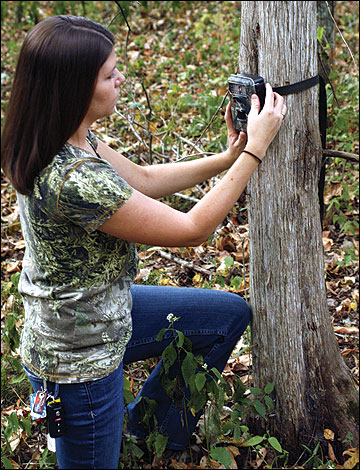 Figure 1. Camera surveys are an excellent method for collecting population demographic information for the local deer herd that can be used when developing a deer management plan.
Figure 1. Camera surveys are an excellent method for collecting population demographic information for the local deer herd that can be used when developing a deer management plan.
Adult sex ratio
A deer herd’s adult sex ratio indicates the number of adult bucks relative to the number of adult does in the herd. One buck to two-to-three does is an optimal goal in most situations.
The adult sex ratio of a herd can usually be balanced by harvesting more does than bucks. However, achieving the proper sex ratio through harvest management will depend on numerous circumstances. Often, balance can be achieved within one hunting season, particularly in rural areas of Missouri with unlimited antlerless permits. Achieving a particular adult sex ratio goal in other areas may require inviting hunters to the property to harvest an adequate number of does.
Continue to monitor the herd after the desired ratio has been achieved, as a deer herd’s adult sex ratio can become unbalanced within a short time if proper harvest practices are not implemented each year.
Fawn recruitment
Fawn recruitment is defined as the number of fawns that survive into the breeding population in a given year. Steps can be taken to improve fawn recruitment through appropriate harvest and habitat management activities (Figure 2). For example, the availability of high-quality bedding cover is essential for fawn survival and recruitment into the adult population. High-quality bedding cover is often defined as early successional habitat containing vegetation such as warm season grasses and broad-leaved plants called forbs. This type of habitat is important for deer of all ages, but it is especially important for concealing fawns during their first few months of life. The time frame for creating or improving this habitat will depend on the existing vegetation. A timely timber-thinning operation or disking of an old field can encourage early successional vegetative growth within a few weeks or months, whereas restoring warm season grasses may take a couple of years.
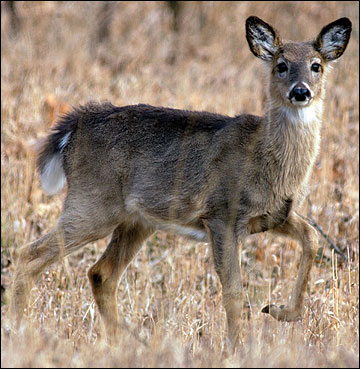 Figure 2. Increasing the quality and quantity of fawning habitat can often increase fawn recruitment within a population.
Figure 2. Increasing the quality and quantity of fawning habitat can often increase fawn recruitment within a population.
Buck age structure
Improving the buck age structure of the population is often the most difficult and long-term management objective. The time frame needed to accomplish this objective often depends on the buck age structure when QDM is implemented and the participants’ dedication in implementing the appropriate harvest practices (Figure 3).
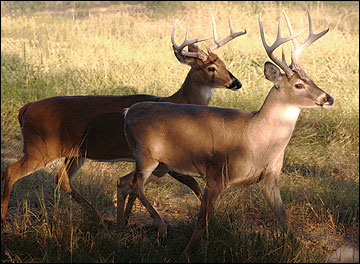 Figure 3. Increasing the number of bucks in older age classes is a common objective that leads to a greater number of bucks with larger antler sizes, but this objective requires adequate acreage under management and several years to achieve.
Figure 3. Increasing the number of bucks in older age classes is a common objective that leads to a greater number of bucks with larger antler sizes, but this objective requires adequate acreage under management and several years to achieve.
Below are two examples that demonstrate how the buck age structure might be altered and how property characteristics can influence the outcome of management practices:
- Example 1
On a 1,500 acre property, 70 percent of the buck portion of the herd is composed of yearling bucks (1-1/2 years old). No bucks 3-1/2 years old or older have been observed or harvested. Allowing the majority of yearling bucks to survive each year and increasing the proportion of older bucks (3-1/2 and older) may take as long as three years to accomplish with limited or no buck harvest. In most cases, imposing an age harvest criteria is the ideal approach to this objective. (Refer to MU Extension publication G9485, Techniques for Aging Live Deer). - Example 2
On a property smaller than 1,500 acres, no bucks 3-1/2 years old or older have been observed or harvested. Due to the relatively small acreage, impacting and improving the age structure of the buck segment of the population would be difficult without cooperation from neighboring landowners. A buck’s home range can be several hundred to over a thousand acres. Therefore, neighboring landowners and hunters must collectively develop harvest management strategies to allow young bucks to mature into older age classes. Without cooperation among landowners and hunters within the area, improving the buck age structure may take an extremely long time or be impossible. Refer to MU Extension publication G9490, Managing for White-tailed Deer in Missouri: Establishing a Wildlife Management Cooperative for information on creating a successful cooperative.
Habitat management
High-quality habitat can provide all the necessary food, cover and water requirements of deer throughout the year. Deer have adapted to live in a variety of habitats throughout Missouri; however, the health of a particular deer herd at any given time or location depends on the management decisions made by landowners and hunters. Land-use patterns and composition of the habitat in an area also have a tremendous influence on deer populations and their movements. Enhancing the habitat quality for deer on a property requires an investment of time and money, but the resulting improvements in deer herd health and property use will be observed for many years.
Common land-use practices in Missouri include agriculture, timber, pasture and livestock production. All land-use practices have significant impacts on local deer populations because how the land is managed influences the availability of food and cover for deer. The particular habitat types on a property provide insight into the implementation and response time for individual habitat improvements. In general, three habitat types dominate Missouri: woodlands, grasslands and croplands.
Woodlands
Depending on an individual landowner’s goals, managing woodlands for deer habitat usually involves creating a disturbance such as conducting a timber harvest, timber stand improvement or prescribed fire (Figure 4). These disturbance techniques can be used to open the woodland canopy and allow more sunlight to reach the soil. This increased sunlight stimulates the growth of nutritious woody browse and herbaceous vegetation (nonwoody plants) closer to the ground, increasing the forage available for deer. Timber stand improvement practices can be conducted to retain high-quality mast-producing trees, such as oak and persimmon, within the stand, while removing less desirable trees. Prescribed fire can be used to create and maintain early successional vegetation within a woodland. Conducting either of these practices can stimulate forage production during the next growing season, although increased mast production may take several years to be realized.
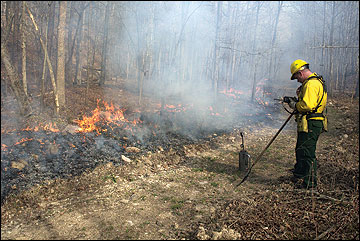 Figure 4. The use of a prescribed fire, a recommended management technique in a variety of habitats including woodlands, results in an increase in the quantity and nutritional quality of forage available to deer.
Figure 4. The use of a prescribed fire, a recommended management technique in a variety of habitats including woodlands, results in an increase in the quantity and nutritional quality of forage available to deer.
Grasslands
The management techniques to implement in open areas dominated by pastures and grasslands will vary depending on the existing conditions. Grasslands dominated by perennial cool-season grasses such as tall fescue provide little cover or forage for deer during the year, especially during winter snowstorms when cover is in high demand. Native warm season grasses (NWSGs) and forbs provide nutritious forage and important cover during the summer and winter months. The transition into NWSGs and forbs requires additional management, such as herbicide treatments or prescribed fire at the appropriate time.
Grasslands left unmanaged are often encroached upon by invasive woody species. Removing these woody species before attempting to improve beneficial herbaceous forbs and grasses is a necessity. Invasives such as eastern red cedar can be eliminated by cutting, whereas hardwoods such as honey locust require cutting and herbicide application.
Croplands
Agricultural croplands are often the most productive locations for providing a tremendous quantity of high-quality forage or cover. Nutrient-rich soils have the potential to improve a herd’s body growth, antler development and reproduction (gestation and lactation). Croplands can be managed for economic and wildlife benefits simultaneously or can be transitioned into areas for wildlife habitat with relatively little effort.
Antler expectations
Increasing the average antler score in a herd may be an important management objective for some landowners, hunters and wildlife management cooperatives. Three components are often overlooked that can have a large effect on antler growth:
- The area’s existing soil quality and resultant plant nutrition
- The herd’s buck age structure
- The individual’s genetic potential
Soil quality and nutrition
Soil fertility influences the nutritional quality of the browse and forage within a particular area. For example, a highly preferred plant of white-tailed deer such as greenbrier can have 13 percent more crude protein in areas of high soil fertility than it has in areas of lower soil fertility (Figure 5).
Soil conditions are highly variable across Missouri. For example, much of northern Missouri has deep, nutrient-rich soils that support agriculture and crop production. In the Ozark region of Missouri, soils are generally not as fertile and much of the land is dominated by a mixture of forest and grassland habitat. Nutrient-rich soil does exist in southern Missouri, but it does not dominate the landscape as in northern Missouri. In southern Missouri, fertile soils are often held in river bottoms or other low areas. These differences in land use and soil quality can greatly affect deer antler and body size, and influence pregnancy rates. Although the potential to produce large-antlered bucks is possible in areas of low soil fertility, the average antler growth in these areas will rarely match that of herds in areas of high soil fertility. MU Extension publication G9479, Ecology of White-tailed Deer in Missouri, provides more information on how soil fertility influences deer antler and body size. Soil can be tested to determine its fertility and fertilizer needs for various crops. For information on how to collect and send soils for analysis, visit the MU Soil and Plant Testing Laboratory website, extension.missouri.edu/programs/soil-and-plant-testing-laboratory/spl-soil-analysis.
Habitat management practices can influence antler size. Habitat improvements can be implemented in a variety of ways, including increasing forage and cover availability by managing early successional habitats, promoting mast-producing trees or establishing high-quality food plots.
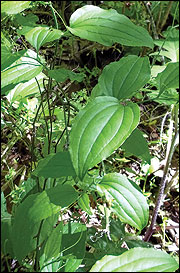 Figure 5. The protein in plants such as greenbrier can vary dramatically based on soil fertility and conditions.
Figure 5. The protein in plants such as greenbrier can vary dramatically based on soil fertility and conditions.
Buck age structure
Improving the buck age structure by allowing more bucks to mature into older age classes is one of the best methods for increasing antler size because it requires no physical or monetary inputs, just harvest management (Figure 6). Understanding the rate of antler growth relative to age is important when developing a harvest plan. Research has determined the average percentage of maximum antler growth bucks achieve at each age class:
- 1-1/2 years old = 29 percent
- 2-1/2 years old = 61 percent
- 3-1/2 years old = 79 percent
- 4-1/2 years old = 91 percent
- 5-1/2 years old = 98 percent
- 6-1/2 years old = 100 percent
Hunters can use this information to avoid high-grading, or removal of the largest-antlered bucks in younger age classes. High-grading is one of the most common management mistakes made when the goal is to increase antler size. For example, when hunters consistently harvest the largest-antlered bucks at younger age classes (less than 3-1/2 years old) and do not allow them to mature into older age classes, the herd is left with a larger percentage of bucks with lower antler growth potential. The herd may have a 3-1/2-year-old and a 5-1/2-year-old buck that both score 130 inches. However, the antler growth potential of these deer will vary, as the 3-1/2-year-old would score about 157 inches given the chance to reach 5-1/2 years old.
High-grading does not alter the genetics of a population but instead affects the “standing crop,” or the existing characteristics of a deer herd. Therefore, high-grading can be easily corrected by aging live deer, and thus determining whether a deer is mature or immature, before harvest (Figure 7). For more information, refer to MU Extension publications G9486, Antler Development of White-tailed Deer: Implications for Management, and G9485,Techniques for Aging Live Deer.
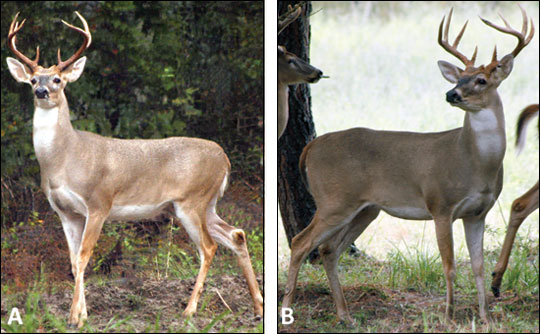
Figure 6. These images show the same buck at 3 years old with an antler score of 107-3/8 inches (a) and at 4 years old scoring 135-2/8 inches (b), demonstrating that antler size increases with age.
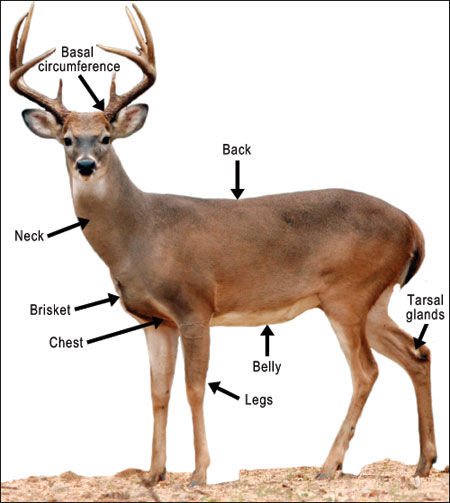 Figure 7. This image indicates common body characteristics involved in aging live deer. Incorporating an age component into harvest criteria often decreases the chances of high-grading.
Figure 7. This image indicates common body characteristics involved in aging live deer. Incorporating an age component into harvest criteria often decreases the chances of high-grading.
Herd genetics
Not all bucks are created equal, as some have the potential to grow larger antlers than others. A wide range of antler scores exist within each age class of bucks in an area. For example, when all antler scores within a buck age class are presented on a graph, they often form a bell-shaped curve (Figure 8). Despite the wide range of scores, most antler scores will be near the average, with only a few deer possessing exceptionally small or large antlers. This range is an important consideration when attempting to increase the average antler score on a property. For every buck that grows exceptionally large antlers, there will be a buck that grows an exceptionally small set of antlers. Neither buck is genetically inferior to the other; they simply possess different antler growth potentials.
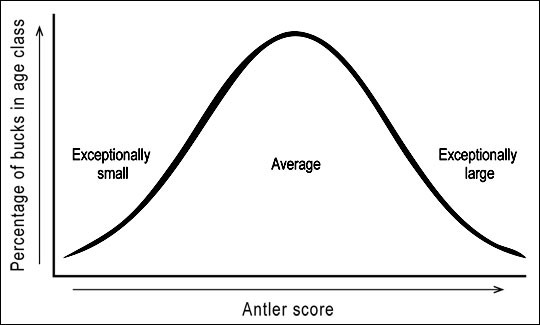
Figure 8. Antler scores for an age class tend to form a bell-shaped curve.
Developing a successful deer management plan
Understanding how factors, both controllable and uncontrollable, affect deer herd health is essential to developing a successful deer management plan. A successful management plan includes the following steps:
1. Set realistic deer management goals for your property
Setting goals is an important aspect of any management plan, but setting goals that are too large or impractical can quickly lead to disappointment. When setting goals for a deer management plan, consider property characteristics such as size and shape, neighbor’s deer management, soil quality, surrounding land use and previous deer management, as these will affect which goals are achievable. Also, consider setting goals with elements that can be achieved in phases. Such goals can be easiest to develop and can keep landowners and hunters encouraged.
2. Determine which management practices to implement
After the goals for a property are set, review management practices and select the practices that will yield the desired results. Possible deer management practices include increasing doe harvest, decreasing hunter density and applying harvest criteria to bucks. The most effective practice depends on the current status of the deer herd.
3. Monitor management progress
Deer management is a dynamic process. Specific goals may vary from year to year, land-use decisions and habitats may change, and the management goals of neighboring landowners may influence the decision-making process. Therefore, collecting data by monitoring the deer herd and habitat quality throughout the year is important. This information will reveal if the deer management plan is succeeding and where management alterations are needed. The optimal method of monitoring the deer herd and determining if the plan is accomplishing its objectives is to collect population data, which can be obtained using harvest records, observation logs and camera surveys. (Refer to the MU Extension publications on estimating deer populations on your property mentioned in the Manipulating population demographics section.)
Conclusion
The development of a successful deer management plan requires an understanding of white-tailed deer ecology and habitat requirements, but equally important is the incorporation of realistic management goals. Many controllable and uncontrollable factors will affect the success of a deer management plan. Each property or wildlife management cooperative may have limitations related to the acreage under management, soil fertility, land-use patterns, neighboring landowners with different goals, and many other factors. Ignoring these factors when developing a plan will likely lead to unrealistic management goals, failure and frustration.
Gathering and incorporating information on the local deer population and habitat characteristics into the decision-making process will greatly increase the chances of success. This information can be used to evaluate whether a particular management goal is achievable. In most cases, success is more achievable when you initially address a couple small-scale management goals and increase the number and scale of goals over time as more information and data are collected. Implementing management practices that benefit the white-tailed deer population and habitat can be very rewarding, particularly when you set goals based on realistic expectations and clearly identify the appropriate actions to take to accomplish those goals.
Numerous educational resources are available to help landowners and hunters interested in managing white-tailed deer on their property, many of which are identified below in the Additional references section and the Also from MU Extension Publications box at the end of this publication. In addition, technical assistance can be obtained by contacting a Missouri Department of Conservation private land conservationist (http://mdc.mo.gov) or a consulting professional wildlife biologist certified by The Wildlife Society (http://www.wildlife.org).
Additional references
- Brothers, A., and M.E. Ray Jr. 1998. Producing quality whitetails (revised edition). San Antonio, TX: Texas Wildlife Association.
- Demarais, S., B.K. Strickland, and W.T. McKinley. 2008. “Managing bucks means managing expectations.” Quality whitetails (June):22–30.
- Jones, P.D., S. Demarais, B.K. Strickland, and S.L. Edwards. 2008. “Soil region effects on white-tailed deer forage protein content.” Southeastern naturalist 7(4):595–606.
- Strickland, B.K., and Demarais, S. 2007. Using antler restrictions to manage for older-aged bucks (Publication 2427). Mississippi State University Extension Service. http://msucares.com/pubs/publications/p2427.pdf.